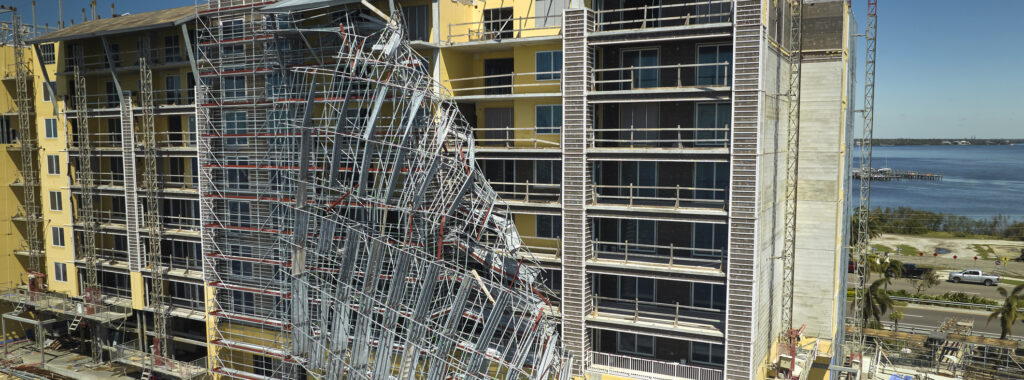
Top Safety Practices to Prevent Scaffold Collapse on Construction Sites
We examine the primary reasons behind scaffold collapses, which are significant safety concerns on construction sites that can result in serious injuries or even death.
Understanding Scaffold Collapse on Construction Sites
Scaffold collapses remain a major issue in the construction industry, especially in New York City. These events can result in critical injuries or deaths, along with considerable damage to property. It is essential that scaffolding adheres to strict safety regulations from its design and construction through daily operation and regular assessments. Adhering to thorough safety procedures greatly diminishes the likelihood of accidents involving scaffolds at building sites.
Scaffold failures can be attributed to several underlying factors which must be vigilantly managed and counteracted. Mistakes made by humans, careless actions, environmental influences, as well as flaws in materials stand out as leading reasons for these types of incidents occurring. Recognizing what leads to these disasters paves the way for enacting robust measures geared toward enhancing scaffold security on job locations.
Human Error and Negligence
Improper assembly, insufficient training, and disregard for safety protocols frequently contribute to scaffold collapses due to human error. Poorly constructed or assembled scaffolding amplifies the danger of collapse, which can result in serious injuries to construction workers. Ensuring that those involved with scaffolding receive specialized instruction is crucial so they are well-versed in safety norms and correct construction methods.
To diminish the chances of accidents, it’s vital that adequately qualified professionals provide scaffold safety training. This enables workers on construction sites to spot potential risks promptly and implement measures to prevent them, thereby lowering the incidence of failures that could lead to collapses and worker injuries.
Environmental Factors
Adverse weather conditions, including strong winds and heavy rain, can negatively impact the stability of scaffolding. To counteract these environmental threats, it is crucial to take them into consideration during both the planning and assembly stages to guarantee scaffold stability.
It is essential that the foundation for any erected scaffold be stable enough to bear not only its own weight but also the additional load from workers and materials. Carrying out an exhaustive investigation of the site along with meticulous planning are key measures in reducing risks associated with environmental influences and ensuring a secure working area for all involved.
Material Failure
Material failure is another critical factor that can lead to scaffold collapses. Using defective or substandard materials compromises the integrity of the scaffolding, increasing the risk of accidents. High-quality materials are crucial to prevent failures and protect workers from injuries.
Inferior materials pose severe safety hazards, putting workers at significant risk of falling and suffering injuries or death. Prioritizing top-grade materials enhances structural integrity and safety.
Common Injuries from Scaffold Collapses
The collapse of a scaffold can lead to an array of injuries, spanning from trivial scrapes and contusions to severe, transformative health conditions. Such incidents stand as one of the primary sources of both injury and death within the construction industry. Not only do victims suffer physical harm when a scaffold fails, but they also experience significant emotional distress and economic burdens that deeply affect them and their loved ones. Addressing these challenges holistically is essential in providing thorough support to facilitate recovery.
Physical Injuries
Accidents involving scaffolds can lead to a range of severe physical harms, such as bone fractures, traumatic injuries to the head, and damage to the spinal cord that may cause paralysis. Frequent injuries involve broken bones in areas like wrists and ankles due to scaffold collapses. These types of injuries typically necessitate comprehensive medical care alongside extended periods for recuperation.
Catastrophic injuries encompass crush trauma when limbs or other body parts are pinned under substantial wreckage—occasionally resulting in amputation—and cuts from objects plummeting down which carry the threat of infection. The seriousness associated with these kinds of harm underscores the imperative nature of robust safety protocols and swift medical intervention following an accident where people become trapped by a collapsing scaffold.
Emotional and Financial Impact
Individuals affected by scaffold accidents frequently encounter a heavy load of medical expenses and income loss. The substantial economic demands stemming from healthcare costs and diminished earnings can lead to profound psychological anguish for both the victims and their family. Consequences such as physical harm coupled with monetary pressures may give rise to mental health issues like anxiety, depression, or post-traumatic stress disorder (PTS
To effectively tackle both emotional well-being and monetary hardships that follow scaffold-related mishaps, an all-encompassing strategy encompassing medical treatment, legal counsel, and mental health support is required. This integrated method is vital in assisting those impacted along their journey towards recovery while also aiding them in piecing back together their lives after such traumatic events.
Legal Steps After a Scaffold Collapse
Understanding the legal procedures following a scaffold collapse is crucial for victims to obtain the compensation they are entitled to. Available avenues such as filing for workers’ compensation claims or third-party lawsuits can greatly influence their journey towards financial recovery and provide necessary support.
It’s important to take prompt action after an accident, initiate the process of claiming compensation, and explore options regarding third-party responsibility in order to safeguard your rights and ensure that you receive adequate assistance in your recovery.
Immediate Actions Post-Accident
In the event of a scaffolding accident, assess any injuries immediately and obtain medical help. This step not only mitigates the risk of additional harm, but also secures records that may support subsequent claims. Capturing details about the scene is imperative for preserving evidence required in potential legal proceedings.
Notifying your employer about the incident sets off the formal process of documentation needed for insurance purposes. It serves as verification for injury reports and guarantees that all mandated reports are completed accurately.
Filing for Compensation
Following a scaffolding collapse, workers who sustained injuries are entitled to seek workers’ compensation and may also file third-party liability claims in New York City, depending on the circumstances. These claims can address an array of losses such as medical expenses, lost earnings, emotional suffering, and provide death benefits for relatives of any worker who has passed away due to the accident. Collecting statements from those who witnessed the event is vital in bolstering legal cases post-accident.
Pursuing Third-Party Liability Claims
After experiencing a scaffold collapse, it’s imperative to grasp your legal avenues as they can profoundly influence the trajectory of your recovery. Initiating compensation procedures may involve making claims against additional parties like contractors or manufacturers who are accountable for the scaffolding mishap. With an extensive history spanning over two and a half decades in dealing with grave injury cases, NTZ Law delivers robust yet empathetic advocacy to ensure clients are justly compensated.
To successfully file third-party liability claims, meticulous investigation and specialized legal knowledge is essential. The team at Law Offices of Nicholas Tzanateas (NTZ) stands ready to pinpoint those liable for the incident and forge a compelling argument that aims to procure the rightful restitution you merit.
How the Law Offices of Nicholas Tzanateas Can Assist You
NTZ Law provides specialized legal assistance to those affected by scaffold accidents, ensuring that their clients are adeptly represented in the pursuit of rightful compensation. The firm is dedicated to advocating for victims of such incidents with a vigorous commitment, offering expert guidance through the complex territory of personal injury law.
Expertise in NYC Personal Injury Cases
Boasting a quarter-century of expertise, NTZ Law is proficient in handling grave and devastating injury claims stemming from construction mishaps. Their profound experience affords them the capability to adeptly navigate scaffold-related accidents and achieve just recompense on behalf of their clients.
NTZ Law demonstrates its unwavering commitment to representing those harmed through its tailored approach to each situation they encounter. The firm’s prowess in personal injury legislation positions them favorably when addressing the specific challenges and details pertinent to claims involving scaffolding accidents.
Areas of Service
NTZ Law provides expert legal assistance to individuals impacted by scaffold accidents across the New York City region, covering all five boroughs—Brooklyn, Bronx, Manhattan, Queens, and Staten Island—as well as the neighboring counties of Westchester, Nassau, and Suffolk. This wide-ranging service territory guarantees that clients from various locations can receive professional legal support.
Preventative Measures to Avoid Scaffold Collapses
Preventing scaffold collapses ensures a safer building construction environment for the construction worker. Proper safety measures significantly reduce the risk of accidents and protect workers from harm.
Proper Training and Supervision
Thorough instruction for employees markedly diminishes the chances of accidents involving scaffolding. It’s crucial that these programs include instructions on how to properly erect, utilize, and respond in emergencies related to scaffolding. This ensures that workers are well-versed in safety measures and recognize the value of skilled oversight.
Having appropriate leadership onsite guarantees adherence to safety guidelines and swift management of any emerging risks. Skilled overseers have the ability to spot and rectify problems before they escalate into incidents, thus improving overall safety at the construction site.
Regular Inspections and Maintenance
Regular inspections of scaffolding are crucial to detect and correct possible dangers prior to the commencement of work. These routine checks assist in identifying any deficiencies, confirming adherence to safety regulations, and mitigating potential risks that could cause mishaps.
By conducting consistent evaluations, emerging problems can be resolved, upholding the structural soundness of the scaffold and securing a safer working space for construction workers.
Use of Quality Materials
Choosing top-tier materials for scaffold construction is crucial to mitigate the risk of structural collapse and improve safety measures. Materials such as steel and aluminum significantly boost the durability and security of scaffolding frameworks.
By investing in superior quality materials, you can ensure that scaffolds are robust enough to endure the rigors of construction while minimizing chances of failure. Emphasizing premium material selection during scaffold assembly is essential for safeguarding worker welfare and maintaining solid structure integrity.
Frequently Asked Questions
How many people fall off scaffolding?
Scaffold-related accidents result in approximately 60 deaths and 4,500 injuries annually, with falls accounting for about 25% of all fatal falls from working surfaces.
It is essential to prioritize scaffolding safety to mitigate these risks.
What is the #1 injury when using scaffolding?
Falling from scaffolding is the most common injury encountered when using this equipment, often leading to severe and potentially fatal injuries, especially from significant heights.
Prioritizing safety measures and proper training is essential to mitigate these risks.
What is scaffold collapse?
Scaffold collapse is a dangerous event that poses serious risks to construction workers and nearby individuals, occurring when these temporary support structures fail and compromise safety.
It is crucial to ensure proper inspection and maintenance to prevent such incidents.
What are the main causes of scaffold collapses?
The main causes of scaffold collapses are human error and negligence, environmental factors, and material failure.
Addressing these issues is vital to ensuring workplace safety.
What types of injuries can result from scaffold collapses?
Collapses of scaffolding may lead to a range of harm, from superficial wounds such as scrapes and contusions to more grave injuries including broken bones, cranial damage, spinal afflictions, and even life-threatening outcomes.
Implementing rigorous safety protocols is essential in averting these kinds of accidents.

